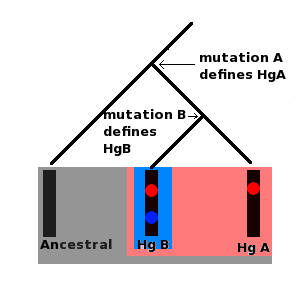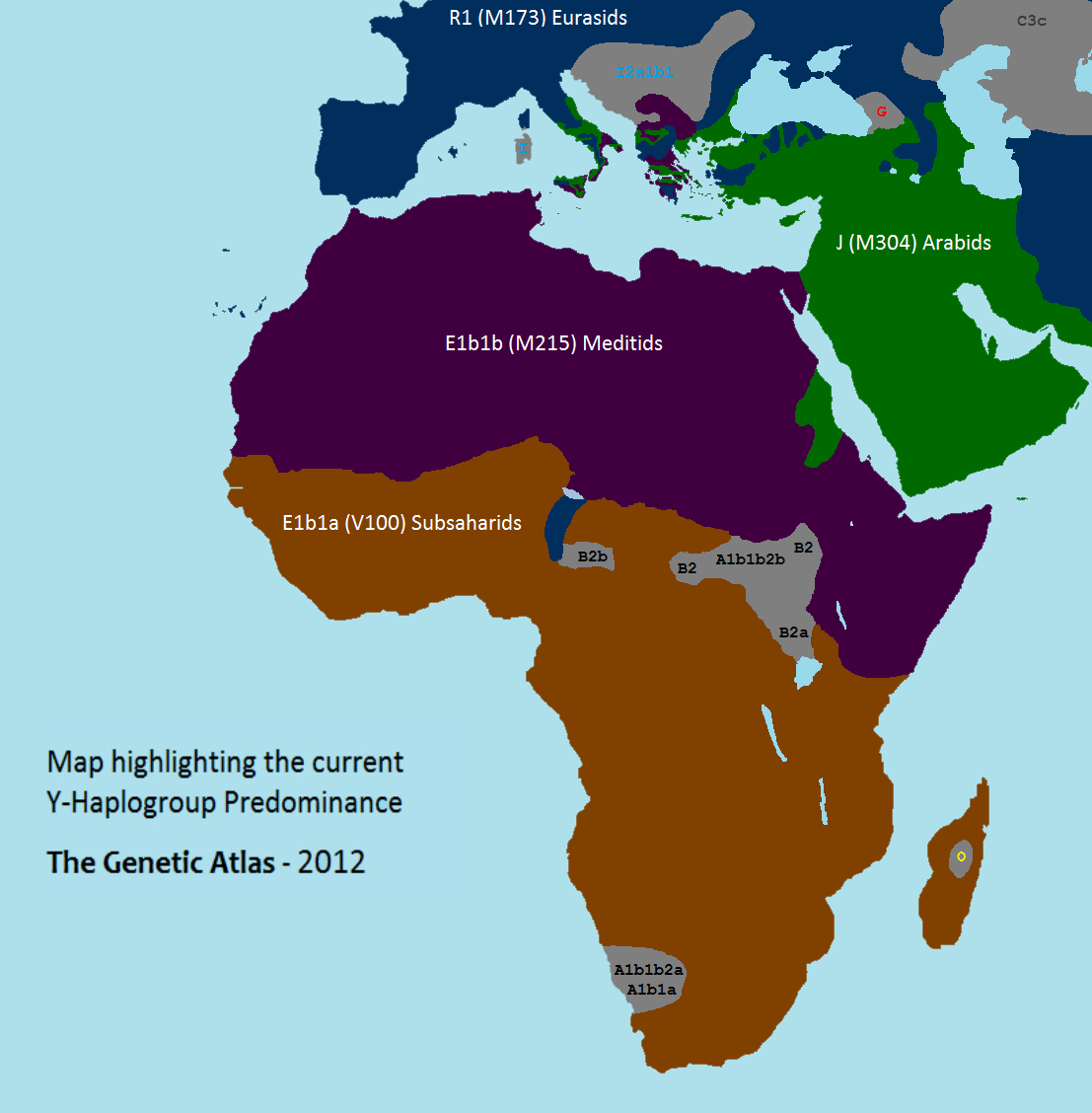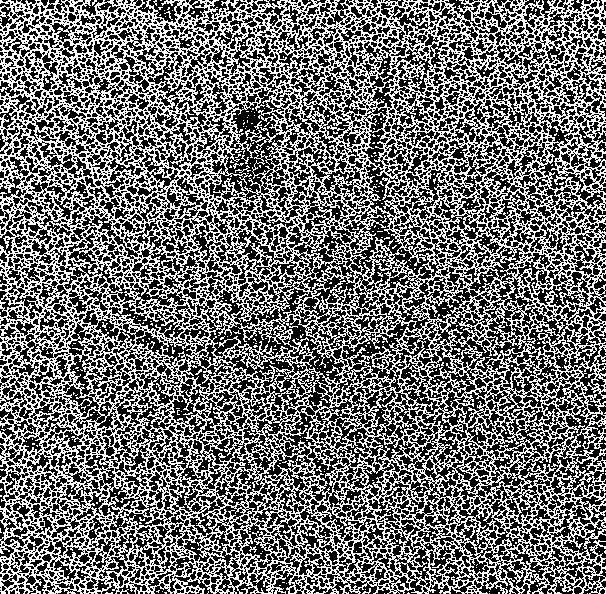|
Haplogroup E1b1a (Y-DNA)
Haplogroup E-V38 is a human Y-chromosome DNA haplogroup. It is primarily distributed in Sub Saharan Africa. E-V38 has two basal branches, E-M329 (formerly E1b1c or E1b1*) and E-M2 (formerly E3a & E1b1a). The E-M329 subclade is today almost exclusively found in Ethiopia. E-M2 is the predominant subclade in Western Africa, Central Africa, Southern Africa and the region of African Great Lakes, and occurs at only moderate frequencies in some parts of North Africa, West Asia and Southern Europe. Origins The discovery of two SNPs (V38 and V100) by Trombetta et al. (2011) significantly redefined the E-V38 phylogenetic tree. This led the authors to suggest that E-V38 may have originated in East Africa. V38 joins the West African-affiliated E-M2 and the northern East African-affiliated E-M329 with an earlier common ancestor who, like E-P2, may have also originated in East Africa. The downstreams SNP E-M180 may have originated on the moist south-central Saharan savannah/grassland of North ... [...More Info...] [...Related Items...] OR: [Wikipedia] [Google] [Baidu] |
Horn Of Africa
The Horn of Africa (HoA), also known as the Somali Peninsula, is a large peninsula and geopolitical region in East Africa.Robert Stock, ''Africa South of the Sahara, Second Edition: A Geographical Interpretation'', (The Guilford Press; 2004), p. 26 Located on the easternmost part of the African mainland, it is the fourth largest peninsula in the world. It is composed of Ethiopia, Eritrea, Somalia and Djibouti; broader definitions also include parts or all of Kenya, Sudan, South Sudan, and Uganda. The term Greater Horn Region (GHR) can additionally include Burundi, Rwanda, and Tanzania. It lies along the southern boundary of the Red Sea and extends hundreds of kilometres into the Guardafui Channel, Gulf of Aden, and Indian Ocean and shares a maritime border with the Arabian Peninsula of Western Asia. Names This peninsula has been known by various names. Ancient Greeks and Romans referred to it as Regio Aromatica or Regio Cinnamonifora due to the aromatic plants or as Regio I ... [...More Info...] [...Related Items...] OR: [Wikipedia] [Google] [Baidu] |
Haplogroup B-M60
Haplogroup B (M60) is a human Y-chromosome DNA haplogroup common to paternal lineages in Africa. It is a primary branch of the haplogroup BT. B (M60) is common in parts of Africa, especially the tropical forests of West-Central Africa. It was the ancestral haplogroup of not only modern Pygmies like the Baka and Mbuti, but also Hadzabe from Tanzania, who often have been considered, in large part because of some typological features of their language, to be a remnant of Khoisan people in East Africa. Distribution According to one study of the Y-DNA of populations in Sudan, haplogroup B-M60 is found in approximately 30% (16/53) of Southern Sudanese, 16% (5/32) of local Hausa people, 14% (4/28) of the Nuba of central Sudan, 3.7% (8/216) of Northern Sudanese (but only among Copts and Nubians), and 2.2% (2/90) of Western Sudanese. According to another study, haplogroup B is found in approximately 15% of Sudanese males, including 12.5% (5/40) B2a1a1a1 (M109/M152) and 2.5% (1/40 ... [...More Info...] [...Related Items...] OR: [Wikipedia] [Google] [Baidu] |
Haplogroup E-M58 (Y-DNA)
A haplotype is a group of alleles in an organism that are inherited together from a single parent, and a haplogroup ( haploid from the el, ἁπλοῦς, ''haploûs'', "onefold, simple" and en, group) is a group of similar haplotypes that share a common ancestor with a single-nucleotide polymorphism mutation. More specifically, a haplogroup is a combination of alleles at different chromosomal regions that are closely linked and that tend to be inherited together. As a haplogroup consists of similar haplotypes, it is usually possible to predict a haplogroup from haplotypes. Haplogroups pertain to a single line of descent. As such, membership of a haplogroup, by any individual, relies on a relatively small proportion of the genetic material possessed by that individual. Each haplogroup originates from, and remains part of, a preceding single haplogroup (or paragroup). As such, any related group of haplogroups may be precisely modelled as a nested hierarchy, in which each set (h ... [...More Info...] [...Related Items...] OR: [Wikipedia] [Google] [Baidu] |
Haplogroup E-M2 (Y-DNA)
Haplogroup E-M2 (or E1b1a) is a human Y-chromosome DNA haplogroup. It is primarily distributed in sub-Saharan Africa. E-M2 is the predominant subclade in West-Central Africa, Southern Africa and the African Great Lakes, and occurs at moderate frequencies in North Africa and Middle East. E-M2 has several subclades, but many of these subhaplogroups are included in either E-L485 or E-U175. E-M2 is especially common in native Africans speaking Niger-Congo languages and was spread to Southern and Eastern Africa through the Bantu expansion. Origins The discovery of two SNPs (V38 and V100) by Trombetta et al. (2011) significantly redefined the E-V38 phylogenetic tree. This led the authors to suggest that E-V38 may have originated in East Africa. E-V38 joins the West African-affiliated E-M2 and the northern East African-affiliated E-M329 with an earlier common ancestor who, like E-P2, may have also originated in East Africa. The downstreams SNP E-M180 possibly originated on the moist so ... [...More Info...] [...Related Items...] OR: [Wikipedia] [Google] [Baidu] |
Haplogroup E-M54 (Y-DNA)
A haplotype is a group of alleles in an organism that are inherited together from a single parent, and a haplogroup (haploid from the el, ἁπλοῦς, ''haploûs'', "onefold, simple" and en, group) is a group of similar haplotypes that share a common ancestor with a single-nucleotide polymorphism mutation. More specifically, a haplogroup is a combination of alleles at different chromosomal regions that are closely linked and that tend to be inherited together. As a haplogroup consists of similar haplotypes, it is usually possible to predict a haplogroup from haplotypes. Haplogroups pertain to a single line of descent. As such, membership of a haplogroup, by any individual, relies on a relatively small proportion of the genetic material possessed by that individual. Each haplogroup originates from, and remains part of, a preceding single haplogroup (or paragroup). As such, any related group of haplogroups may be precisely modelled as a nested hierarchy, in which each set (hapl ... [...More Info...] [...Related Items...] OR: [Wikipedia] [Google] [Baidu] |
Haplogroup E-M75 (Y-DNA)
Haplogroup E-M75 is a human Y-chromosome DNA haplogroup. Along with haplogroup E-P147, it is one of the two main branches of the older haplogroup E-M96. Distribution Sorted frequency table of E-M75+ populations. Note that a "?" specifies that the sublineage of E-M75 was either untested for or unreported in the relevant study. Subclades Paragroup E-M75 Haplogroup E-M75(xM41,M54) has been found in 6% (1/18) of a sample of Dama from Namibia, 4% (1/26) of a sample of Ganda from Uganda, 3% (1/39) of a sample of Mandinka from Gambia/Senegal, and 2% (1/49) of a sample of Shona from Zimbabwe. E-M41 Haplogroup E-M41 has been found mainly in populations of the Great Lakes and Upper Nile regions of Central-East Africa, including 67% (6/9) of a sample of Alur from the DRC, 39% (7/18) of a sample of Hema from the DRC, 17% (15/88) of a sample from Ethiopia, 8% (2/26) of a sample of Ganda from Uganda, 5% (2/40) of a sample from Sudan, 4% (3/69) of a sample of Hutu from Rwanda, 3% (1/29) ... [...More Info...] [...Related Items...] OR: [Wikipedia] [Google] [Baidu] |
Haplogroup E-M44 (Y-DNA)
A haplotype is a group of alleles in an organism that are inherited together from a single parent, and a haplogroup (haploid from the el, ἁπλοῦς, ''haploûs'', "onefold, simple" and en, group) is a group of similar haplotypes that share a common ancestor with a single-nucleotide polymorphism mutation. More specifically, a haplogroup is a combination of alleles at different chromosomal regions that are closely linked and that tend to be inherited together. As a haplogroup consists of similar haplotypes, it is usually possible to predict a haplogroup from haplotypes. Haplogroups pertain to a single line of descent. As such, membership of a haplogroup, by any individual, relies on a relatively small proportion of the genetic material possessed by that individual. Each haplogroup originates from, and remains part of, a preceding single haplogroup (or paragroup). As such, any related group of haplogroups may be precisely modelled as a nested hierarchy, in which each set (hapl ... [...More Info...] [...Related Items...] OR: [Wikipedia] [Google] [Baidu] |
Haplogroup E-M33 (Y-DNA)
Haplogroup E-M132, formerly known as E-M33 (E1a), is a human Y-chromosome DNA haplogroup. Along with E-P177, it is one of the two main branches of the older E-P147 paternal clade. E-M132 is divided into two primary sub-branches, E-M44 and E-Z958, with many descendant subclades. Distribution E-M132 is found most often in West Africa, and today it is especially common in the region of Mali. One study has found haplogroup E-M132 Y-chromosomes in as much as 34% (15/44) of a sample of Malian men, including 2/44 E-M44 and 13/44 E-M33/M132(xE-M44).Peter A. Underhill, Peidong Shen, Alice A. Lin ''et al.'', "Y chromosome sequence variation and the history of human populations," ''Nature Genetics'', Volume 26, November 2000 In particular, the Dogon people of Mali have been found to carry haplogroup E-M132 with a frequency as high as 45.5% (25/55). This makes it perhaps the most common Y-DNA haplogroup in this population, though haplogroup E-P1 appears to be almost equally frequent am ... [...More Info...] [...Related Items...] OR: [Wikipedia] [Google] [Baidu] |
Haplogroup E-M96 (Y-DNA)
Haplogroup E-M96 is a human Y-chromosome DNA haplogroup. It is one of the two main branches of the older and ancestral haplogroup DE, the other main branch being haplogroup D. The E-M96 clade is divided into two main subclades: the more common E-P147, and the less common E-M75. Origins Underhill (2001) proposed that haplogroup E may have arisen in East Africa. Some authors as Chandrasekar (2007), accept the earlier position of Hammer (1997) that Haplogroup E may have originated in West Asia, given that: * E is a clade of Haplogroup DE, with the other major clade, haplogroup D, being exclusively distributed in Asia. * DE is a clade within M168 with the other two major clades, C and F, considered to have already a Eurasian origin. However, several discoveries made since the Hammer articles are thought to make an Asian origin less likely: # Underhill and Kivisild (2007) demonstrated that C and F have a common ancestor meaning that DE has only one sibling which is non-African. ... [...More Info...] [...Related Items...] OR: [Wikipedia] [Google] [Baidu] |
Omotic Languages
The Omotic languages are a group of languages spoken in southwestern Ethiopia, in the Omo River region. The Ge'ez script is used to write some of the Omotic languages, the Latin script for some others. They are fairly agglutinative and have complex tonal systems (for example, the Bench language). The languages have around 6.2 million speakers. The group is generally classified as belonging to the Afroasiatic language family, but this is disputed by some. Four separate "Omotic" groups are accepted by ''Glottolog'' 4.0 and Güldemann (2018): Ta-Ne-Omotic, Dizoid (Maji), Mao, and Aroid ("South Omotic"). Languages The North and South Omotic branches ("Nomotic" and "Somotic") are universally recognized, with some dispute as to the composition of North Omotic. The primary debate is over the placement of the Mao languages. Bender (2000) classifies Omotic languages as follows: *South Omotic / Aroid ( Hamer-Banna, Aari, Dime, Karo) *North Omotic / Non-Aroid ** Mao *** Bambassi * ... [...More Info...] [...Related Items...] OR: [Wikipedia] [Google] [Baidu] |
Southern Nations, Nationalities, And Peoples' Region
The Southern Nations, Nationalities, and Peoples' Region (often abbreviated as SNNPR; am, የደቡብ ብሔር ብሔረሰቦችና ሕዝቦች ክልል, Yädäbub Bḥer Bḥeräsäbočna Hzboč Kllə) is a regional state in southwestern Ethiopia. It was formed from the merger of five ''kililoch'', called Regions 7 to 11, following the regional council elections on 21 June 1992. Its government is based in Hawassa. The SNNPR borders Kenya to the south (including a small part of Lake Turkana), the Ilemi Triangle (a region claimed by Kenya and South Sudan) to the southwest, the South West Ethiopia Region to the west, the Oromia Region to the north and east, and the Sidama Region to the east. The region's major cities and towns include Arba Minch, Sodo, Jinka, Dila, Boditi, Areka, Butajira, Welkite, Bonga, Hosaena and Worabe. The regional government of the Southern Nations, Nationalities, and Peoples' Region is based in the city of Hawassa. Following the formation of the S ... [...More Info...] [...Related Items...] OR: [Wikipedia] [Google] [Baidu] |
Ancient DNA
Ancient DNA (aDNA) is DNA isolated from ancient specimens. Due to degradation processes (including cross-linking, deamination and fragmentation) ancient DNA is more degraded in comparison with contemporary genetic material. Even under the best preservation conditions, there is an upper boundary of 0.4–1.5 million years for a sample to contain sufficient DNA for sequencing technologies. The oldest sample ever sequenced is estimated to be 1.65 million years old. Genetic material has been recovered from paleo/archaeological and historical skeletal material, mummified tissues, archival collections of non-frozen medical specimens, preserved plant remains, ice and from permafrost cores, marine and lake sediments and excavation dirt. On 7 December 2022, ''The New York Times'' reported that two-million year old genetic material was found in Greenland, and is currently considered the oldest DNA discovered so far. History of ancient DNA studies 1980s The first study of what would ... [...More Info...] [...Related Items...] OR: [Wikipedia] [Google] [Baidu] |






